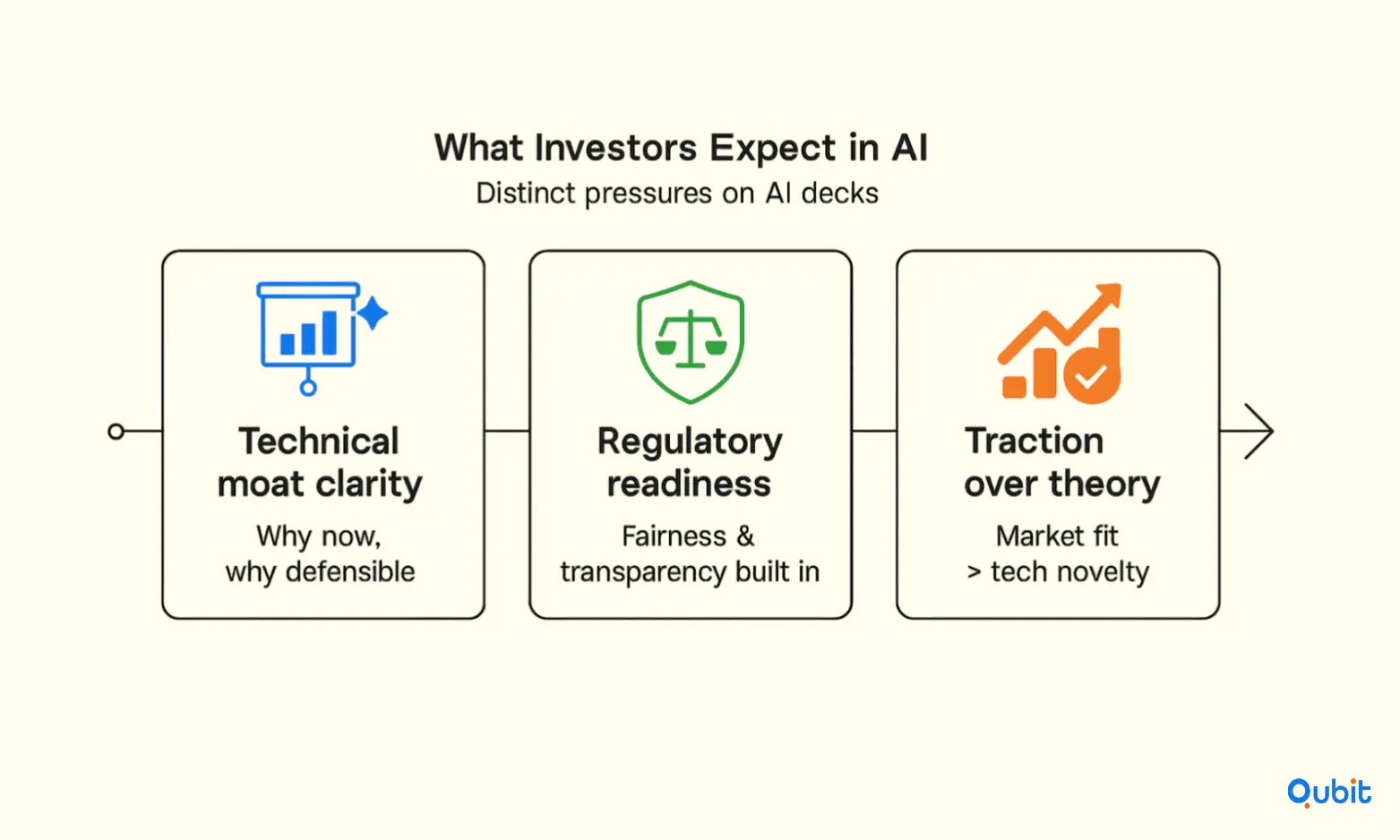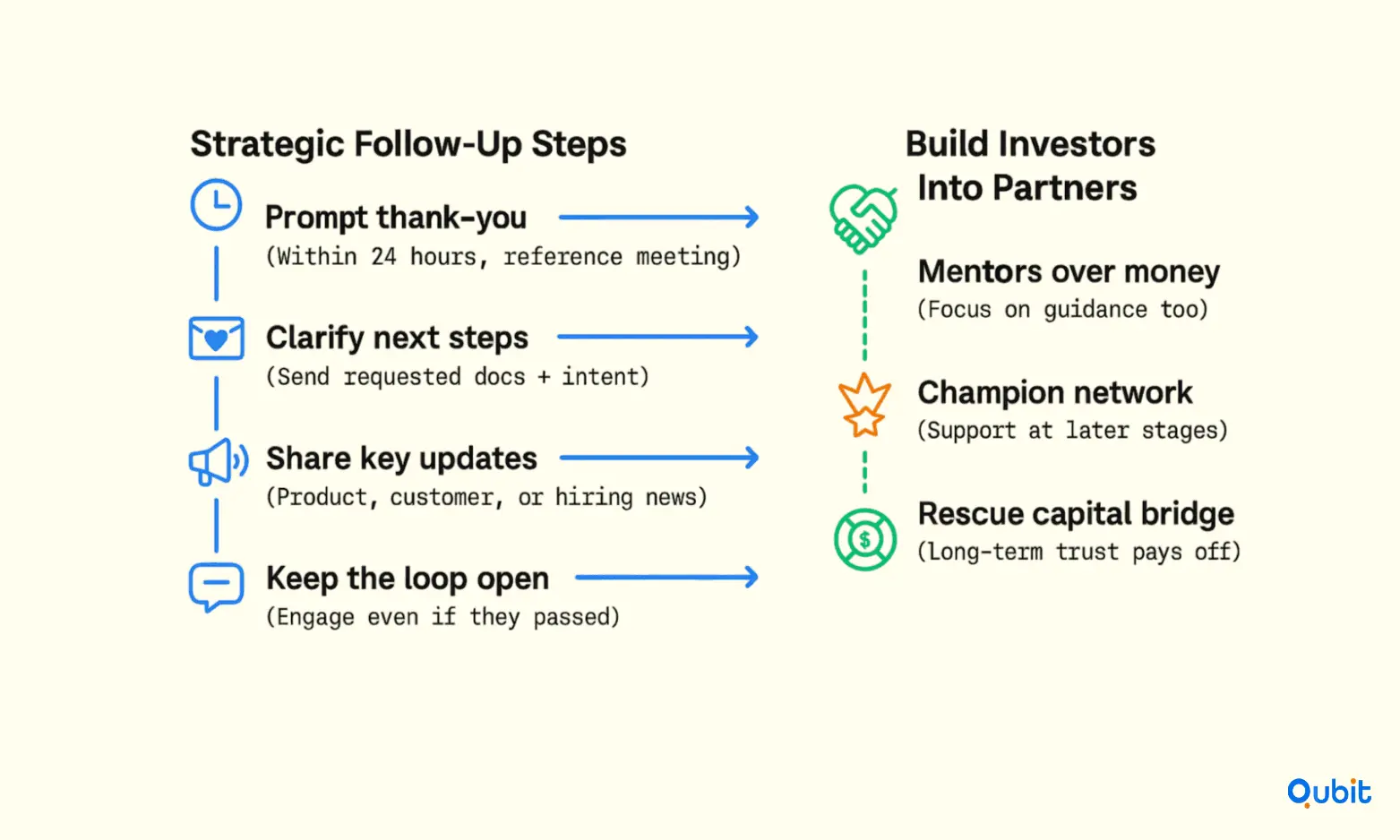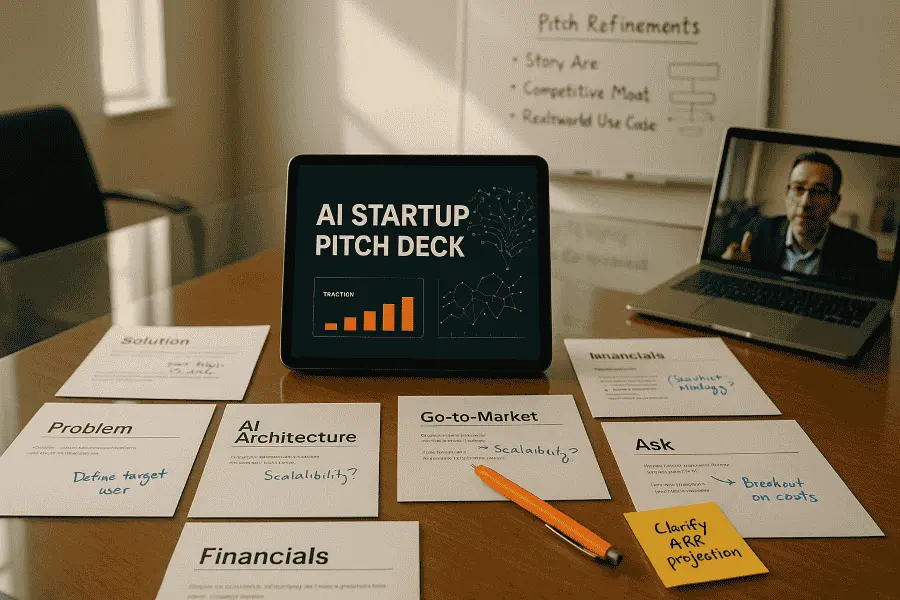A masterful AI pitch deck does not merely transfer information; it builds conviction and emotional connection, translating world-changing ambitions into the crisp logic and memorable moments investors seek. It demystifies deep tech, anchors every slide in real value, and offers a view not just of a product, but of a business, and a team, poised to scale rapidly and responsibly.
In this comprehensive guide, you will discover what separates winning AI pitch decks from the crowd, how to avoid the all-too-common pitfalls of over-complexity and jargon, and a granular breakdown of each slide, spanning problem, market, solution, traction, economics, data moat, ethics, and the ask.
Ready to transform your AI vision into a fundable, repeatable story that compels investor action? Let’s get started.
Why the “AI Pitch Deck” Is Unique
AI startups stand apart from their SaaS and consumer tech counterparts, both in opportunity and in investor expectation. Here's why:

- Technical Depth and Defensibility: Investors dig deeper into the “why now,” the competitive barrier, and especially the data and technical moat.
- Ethical and Regulatory Risks: Given the growing scrutiny on AI’s impact, decks must address fairness, transparency, and compliance.
- Proof, Not Theory: The days of raising on a breakthrough algorithm alone are fading; AI startups must show traction, team fit, and a credible go-to-market strategy.
In short, your pitch deck isn’t just a collection of slides, it’s your case for why your team, right now, with this data and model, is poised to win in a fast-changing landscape. For an overview of the rising standards in AI fundraising, check out the latest in Fundraising Strategies for AI Startups: Strategies and Trends.
Anatomy of the AI Pitch Deck: Slide-by-Slide Breakdown
Slide 1: Cover & One-Line Value Proposition
Start with immediate clarity. Investors should instantly grasp your mission and potential.
- Logo and Branding: Anchors recall.
- Compact One-Liner: “AI-powered medical diagnostics—detecting cancer in 3 minutes, with 92% accuracy.”
- Contact Details: Add founder name(s), email, and website.
Tip: Avoid technical word salad. Clarity signals market readiness, not just intellectual horsepower.
Slide 2: The Problem—Human, Not Technical
Frame a quantifiable, urgent pain that resonates beyond AI specialists.
- Human language: “Warehouses lose $5B annually to supply chain misreporting.”
- Evidence: Data, quotes, mini-case studies.
- Why legacy solutions fall short: Don’t insult—show constraints clearly.
The goal? Anchor your pitch in a “painkiller” problem that investors want to see solved. Drawing on industry insight and real stories moves the problem from the abstract to the investable.
Slide 3: AI-Driven Solution—Impact, Not Features
Present what your product does in plain English before the “how.”
- Outcome-focused: “Cuts logistics error rates by 4x using real-time image classification.”
- Clear workflow: Use simple diagrams—Input > Model > Output.
- No technical overkill: Save those details for the appendix.
Remember: Investors fund business value, not research demos. Decks that lead with impact “stick” far better, as detailed in Do’s & Don’ts for a Winning AI Pitch Deck.
Slide 4: Market Size, Timing, and Segmentation
AI investors want to see:
- Total Addressable Market (TAM): Quantitative, sourced (e.g., “$25B/year global compliance spend”)
- Immediate segment: “Initial wedge: US banks with >$10B in assets ($6B opportunity).”
- Growth drivers: Regulation, tech shifts (GPU cost drops, new data streams), adoption curves.
Credibility and focus outweigh sheer scale. Anchor your wedge and explain the “why now.” For more on blending TAM, SAM, and actionable segmentation, review the fundable deck blueprints in Essential Slides for an AI Startup Pitch Deck: What to Include?.
Slide 5: Product & AI Architecture (For Investors, Not Engineers)
- Tech stack overview: Data in, pre-processing, model(s), outputs, feedback loop.
- What’s proprietary: “We’ve built a real-time, adaptive NLP engine unique to financial documentation.”
- Deployment: SaaS API, on-premise, hybrid edge, etc.
Keep it to one slide. Deep dives can go in the appendix or data room.
Slide 6: Proprietary Data Advantage—The True Moat
Showcase your unique dataset(s), annotation, or data access.
- Volume with signal: “30M labeled radiology images, sourced via exclusive partnerships.”
- Barriers: Cost, privacy, long-tail data, industry buy-in.
- Quality controls: Annotation QA, synthetic data, continual enrichment.
Clear data advantage beats abstract “AI” defensibility every time.
Slide 7: Business Model—Frictionless, Predictable, Scalable
- Pricing model: Per-API call, subscription, usage-tiered, revenue share.
- Customer journey: How you cross-sell, expand, and upsell.
- Margin logic: How scale lowers COGS (model distillation, automated labeling reductions).
Clarity here signals business rigor, not just tech brilliance.
Slide 8: Go-to-Market & Distribution
AI products rarely sell themselves. Show:
- Funnel: Land-and-expand, pilot conversion, partner plays.
- Sales motion: Direct, channel, self-serve.
- Early adopters: Customer logos, pipeline, beta metrics.
Decks that map the exact path from pilot to value generate more investor conviction.
Slide 9: Traction—Proof of Progress
Investors want to know: Is this more than a science project?
- Live deployments: Paid pilots, revenue, user growth curves.
- Key KPIs: Inference volume, retention, accuracy gains, NPS, logo list.
- Graphs, not sentences: Visuals catch the eye.
Early-stage? Share design wins, community adoption, or IP validation.
Slide 10: Competitive Landscape—Show Your Moat
- Comparison grid: You vs. legacy, vs. emerging, vs. DIY.
- Moats: Data access, distribution, regulatory, model performance.
- Unfiltered: Show where you lose—then show the roadmap.
Conviction grows when founders demonstrate nose-to-the-grindstone knowledge of the space.
Slide 11: Team—Mission, Technical, Commercial
- Why you? Ex-DeepMind scientists, serial operators, domain execs.
- Roles mapped to milestones: CTO for scale, CBO for partnerships, etc.
- Notable wins: Publications, IP filings, exits, open source.
Founders who pitch team “DNA” aligned to technical and market needs outpace the competition.
Slide 12: Financials & Unit Economics
- 3–5 year model: Revenue, gross margin, costs, burn, break-even.
- CAC/LTV math: Cohort tables, sensitivity bands.
- AI-specific costs: Compute, data labeling, infrastructure.
Sophisticated, but no vanity projections. Address runway and scaling logic.
Slide 13: Responsible AI & Compliance
- Ethical frameworks: Bias detection, explainability, auditability.
- Regulatory prep: GDPR, EU AI Act, HIPAA, sector-specific security.
- Certification roadmaps: SOC 2, ISO, etc.
Slide 14: Funding Ask & Use of Proceeds
- Round size (e.g., $4M Seed on SAFE, 20 months runway)
- Milestones unlocked by funding: Beta launch, regulatory clearance, $1M ARR.
- Breakdown: % to tech, sales, regulatory, data acquisition.
Tie every dollar to incremental de-risking.
Storytelling & Design: The Make-or-Break Element
Narrative Flow
A killer deck leads the investor on a journey—why this problem, why this team, why now, and why it can become a category-defining business.
- Lead with stakes: Hook early.
- Bridge logic: Problem → Solution → Data moat → Economics → Milestone-driven ask.
- Recall moments: Case studies, quotes, before/after visuals.
Visual Hierarchy
- Say it in visuals: Flowcharts, icons, timeline bars.
- White space = Clarity: Resist the “clutter” urge.
- Consistent fonts, branding, and color cues.
Proving “Fundability”: Investor Mindset & Due Diligence
The Investor POV
VCs are hunting for:
- Clarity of Vision: Can I explain this company to my partners?
- Compounding Moat: Does the AI get better (and more defensible) over time?
- Execution signals: Real users, traction curves, pipeline.
- Market inflection: Why does this win now—not next year?
Anticipating Diligence
- Data provenance and privacy: Signed agreements, user consent.
- Model auditability and reproducibility: Documented methods.
- Adherence to evolving AI regulation: Outline frameworks, readiness.
Pitfalls and How to Avoid Them
| Common Mistake | Impact | Solution |
|---|---|---|
| Excessive technical detail on core slides | Investors “glaze over” | Move specs to appendix, keep slides business-first |
| Unclear business/revenue model | Doubts about monetization | Show pricing, margin assumptions |
| Vanity traction (e.g., free pilots, events) | Questions about real demand | Focus on paid users, retention, revenue metrics |
| Ignoring responsible AI or compliance requirements | Red-flag for many VCs | Add a Responsible AI slide |
| Jargon-heavy, generic market sizing | Fails to distinguish company | Make market segmentation and wedge specific |
Practice, Feedback, Iteration
The best decks are not static, they evolve through feedback, real-world meetings, and adaptation to investor questions.
- Start with “practice” investors:
Before aiming for your top-tier venture capital targets, engage with lower-priority investors, angel investors, friendly VCs, or experienced operators who can give honest feedback without the pressure of an immediate “yes” or “no.” These initial meetings are invaluable for surfacing points of confusion, wording that muddles your value proposition, or sections of your market analysis that need more evidence.
Not only does this approach reduce anxiety for high-stakes meetings, but you’ll often turn critical “maybes” into later-stage champions, simply by making them feel included early. - Iterate slides weekly:
Treat pitch deck iteration like product development. After each call or meeting, note which slides sparked questions—or glazed eyes. Did investors get stuck understanding your moat? Were they excited about your traction metrics? Incorporate this feedback rapidly, updating narrative flow, shortening text, enhancing visuals, and clarifying complex ideas for the next set of meetings.
Over weeks, this iterative practice polishes your story, addresses blind spots, and aligns your messaging with investor hot-buttons. - Build a data room as diligence heats up:
As you progress into “serious conversations,” investors require deeper dives: technical documentation, financial models, user metrics, customer contracts, regulatory proof. Start compiling these materials early in a secure data room. This anticipation signals professionalism and keeps the process smooth, especially if you’re targeting investors with rigorous compliance or technical due diligence requirements. - Why this rehearsal process matters:
Each round of feedback builds confidence and sharpens your ability to focus the narrative on what truly drives investor belief. It’s not unusual for founders to revise their decks 10–20 times before and during a fundraising sprint. By continually refining your pitch in real-world settings—and maintaining a responsive, adaptable mindset, your final deck will resonate strongest where it counts: the toughest, most discerning investor meetings.
Delivering the Deck: Presentation Tips
Once your narrative is tight and the slides are sharp, it's all about how you deliver in the moment:
- Short investor attention span:
Modern investors review hundreds of decks monthly. Assume you have just 4–7 minutes of full attention to get your key points across, whether it’s in front of a partner meeting or over Zoom. Prioritize clarity and headline messages right up front: What’s the problem? What’s unique about your tech and data? Why now? - Practice timing:
Practice not just what you say, but how long you spend per slide. Each slide should communicate its core point in under 30 seconds. If you can’t summarize the value of a slide quickly, revise for brevity and directness. Internal team mock-pitches are a powerful way to simulate the pressure of the real thing and spot oversights before they matter. - Slides at a glance:
Every slide should be digestible in 10 seconds or less. Use visuals, charts, and one-sentence headlines to anchor ideas. Avoid crowding slides with text or complex tables—save those for the appendix or data room. - Backup slides ready:
Top investors will drill deep—but not every meeting covers the same questions. Prepare a set of “backup” slides, covering technical deep-dives, competitive analysis, regulatory strategies, or customer case studies. These aren’t part of the core narrative but allow you to pivot and impress when tougher questions arise.
This flexibility demonstrates you’re overprepared—a clear trust signal for institutional backers.
Real-world pitch experiences and the visual principles that grab investor interest are expanded in Lessons from Top AI Startup Pitch Decks: Examples & Analysis.
After the Deck: Next Steps in Fundraising
Securing a meeting is just one part of the journey, what founders do after the pitch often shapes outcomes as much as the narrative itself:

- Prompt, tailored follow-up:
Within 24 hours, send a personalized thank-you note to each partner or associate you met, referencing specific feedback, clarifying a question, or promising a follow-up document. This professional courtesy is remembered and differentiates you from less-prepared founders. - Points of clarification and next steps:
Investors appreciate founders who anticipate questions. If a key data point or report was requested, turn it around quickly, with context and an eye toward advancing the dialogue, not just “checking the box.” Clarify next steps directly: “Looking forward to feedback and happy to schedule a follow-up with our technical lead if useful.” - Open engagement loop:
Don't vanish after one meeting. Continue to provide substance: product launches, updates on customer progress, regulatory milestones (especially in AI industries like health or finance), or new hires of note. Regular, concise milestone updates, even to investors who passed, keep the door open for future rounds. - Relationship vs. transaction:
The goal is not just to close a round, it’s to build a network of champions, mentors, and connectors for all stages of your AI startup. Engage investors as partners, not just sources of cash. Historical data from successful founders shows that those who maintain genuine relationships before, during, and long after a funding event are better positioned for introductions, industry connections, and even “rescue” capital during turbulent times.
Conclusion
The winning decks tell a story that threads through urgent problems, unique technical capabilities, proprietary data, real business traction, and a world-class team ready to execute. They face regulatory questions head-on, map funding to mission-critical milestones, and foster confidence, not confusion.
Fundraising is a journey. Each meeting, slide revision, and conversation sharpens your message and builds the trust needed to scale. With the right preparation, relentless iteration, and a pitch deck that is both data-driven and human, your AI startup can rise above the noise.
Begin building today, with our Pitch deck creation services. Refine your narrative, seek real feedback, and become the founder whose vision investors can’t resist sharing with their partners.
Let’s make your next round the one that sets you on the path to category leadership!
Key Takeaways
- AI pitch decks require unique focus on technical defensibility, business clarity, responsible AI, and traction.
- Start with a clear value proposition and human-centric problem statement.
- Show actionable market sizing and a credible go-to-market motion.
- Prioritize data advantage and business model transparency above pure technical novelty.
- Address compliance and ethics early; build trust through transparency.
- Use internal and external feedback continuously to iterate your narrative.
- Supplement slides with a detailed appendix and data room for due diligence.
- Leverage internal guides and resources for every stage of deck (linked above).
- Think of relationships, not transactions, in both pitch crafting and follow-ups.
- Invest in design, narrative flow, and memorable moments—these close rounds.
Frequently asked Questions
How long should my AI pitch deck be?
15 core slides are standard, with 3–5 in the appendix for technical, legal, or financial detail. Conciseness is key—each slide must earn its place.


 Back
Back



